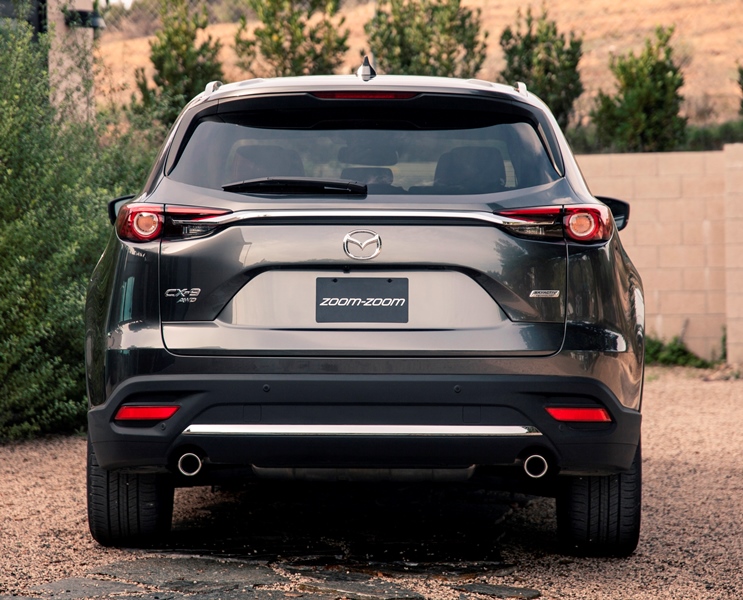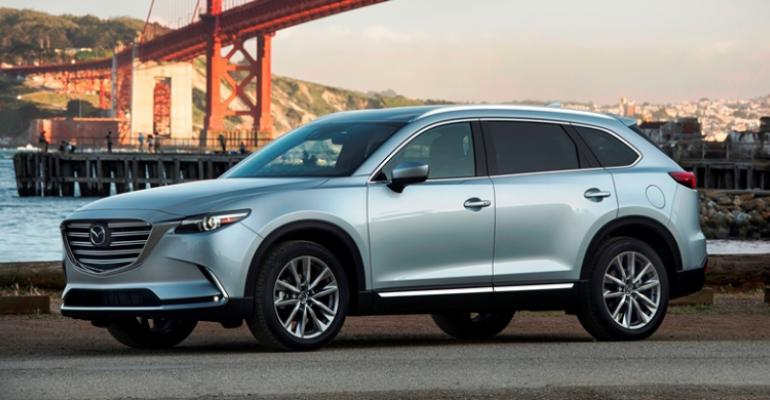SAN FRANCISCO – Mazda designers and engineers have been rubbing the brand’s mojo-rich Skyactiv oil all over the lineup for several years to improve engine output, transmission efficiency, body rigidity and chassis performance.
But there’s been one vehicle sadly overlooked for too long: the forlorn CX-9 CUV, which first arrived in 2007. Consumers largely have ignored it while shopping other 3-row utes such as the Toyota Highlander, Nissan Pathfinder and Honda Pilot.
Mazda has corrected this oversight and, in many ways, has saved the best Skyactiv treatment for last. That’s because the all-new 7-passenger CX-9 achieves many “firsts” for this enthusiast-leaning Japanese brand.
The redesigned CX-9 is the first Mazda with a turbocharged Skyactiv 4-cyl. engine, the first to use real aluminum, wood interior trim and Nappa leather, the first windshield-based head-up active driving display, the first to use lane-keep assist and the first model hailing from the new “Mazda Premium” marketing campaign.
Mazda is billing this family hauler as the brand’s quietest vehicle ever and the most exciting 3-row CUV on the market. True, it sort of seats seven, has a stellar powertrain and handles great, uncharacteristically hugging the road and setting a new standard for the segment.
With all this gotta-have utility, the automaker expects to sell 40,000 CX-9s in North America in its first full year in the market. That’s a tall order based on 2014 and 2015 sales of the previous-generation model.

But consider 2011, when Mazda delivered 34,421 CX-9s here, and the target of 40,000 units across the continent seems attainable, especially if CUV popularity continues unabated.
Perhaps more significant is the rise of Mazda’s 5-passenger ute, the CX-5, which just might outsell the Mazda3 this year and become the brand’s most popular vehicle. CUVs are hot these days, and the new CX-9 would have been riding that tide if only it launched earlier.
Assembled in Hiroshima, Japan, the CX-9 arrives in showrooms this month.
Skyactiv gasoline engines with direct fuel injection, low friction, high compression and all-aluminum construction have been under Mazda hoods since 2012, when the naturally aspirated 2.0L in the Mazda3 won a Wards 10 Best Engines trophy.
A 2.5L version came along soon after, and now those two engines have driven every redesigned Mazda, from sedans and hatchbacks to CUVs and roadsters.
The powertrain transformation is complete in the U.S. with the CX-9, which gets the first Skyactiv gasoline engine with forced induction. Of course, other markets have received Mazda’s Skyactiv 2.2L diesel with a 2-stage turbo, but that engine’s arrival to American shores has been delayed several years, ever since the Skyactiv marketing blitz began. Mazda folks swear the U.S. diesel program is still alive.
The CX-9 doesn’t need a diesel because the new gasoline 2.5L turbo-4 gets the job done quietly and with plenty of vigor, rated at 227 hp with regular unleaded (250 hp with 93-octane) and 310 lb.-ft. (420 Nm) of torque.
It remains composed during extended runs north of 4,000 rpm (shifted into manual mode) even though the 6-speed automatic transmission is programmed to stay in higher gears when accelerating.
Many automatics would hesitate, then kick down a few gears in response to a bootful of throttle, which sucks fuel. But Mazda engineers contend the CX-9 doesn’t need to, thanks to clever features resulting in a lot more torque at low rpm.
4-3-1 Exhaust Enables Scavenging
Helping the turbocharger spool up quickly and mitigate lag is a flow-control valve in the exhaust port, which functions like a thumb at the end of a garden hose. Water will pour gradually until a thumb blocks the flow, creating high pressure that sprays the water.
In the CX-9 engine, the flow-control valve sends more exhaust gas through a smaller port to the turbine wheel, which in turn spins faster, helping the 4-cyl. achieve peak torque by only 2,000 rpm.
The result is an engine that rarely feels taxed. When driving around town, the 2.5L turbo does most of its work at low rpm.
Another “first” for Mazda – and perhaps for all mass-market turbocharged engines – is an ingenious design of the cylinder head that positions the four exhaust runners closely together so cool air from one cylinder joins up with hot exhaust gas exiting a different combustion chamber. The four runners converge into three and then into one, where the air meets the turbocharger. There’s only 1 in. (25.4 mm) of exhaust manifold between the head and turbo.

The benefit of this 4-3-1 layout is enough suction (or “scavenging”) to draw residual hot exhaust gases from each combustion chamber, in sequence, resulting in lower temperatures in each cylinder as it prepares for the next combustion cycle.
Those lower temperatures allow the engine to run at a higher compression ratio of 10.5:1 – which is high for a turbocharged engine – without knocking.
Relative to the naturally aspirated 2.5L I-4, the turbo variant also has new pistons and rods, and the block has minor changes. The crankshaft, originally engineered to handle a lot more torque, is the only major engine part that carries over.
Fans hoping for a renaissance of high-output Mazdaspeed vehicles will be glad to know the new turbo-4 will fit in the engine bay of the Mazda3 and Mazda6.
The 3.7L V-6 in the previous-generation CX-9 made only 270 lb.-ft. (366 Nm) of torque but not until 4,250 rpm, resulting in a lot of shift busy-ness to meet an urgent request from the driver. The old V-6 made more horsepower (273) but required severe caning at 6,250 rpm to exploit all of it.
The departure of the previous-generation CX-9 represents the end of V-6 engines in the Mazda portfolio.
Hello Real Wood; No Cooled Seats
Relative to the old model, the new CX-9 looks like it’s been to the gym, returning with muscular sheet metal, a more steeply raked backlight and liftgate, a higher beltline and a chiseled front end with a recessed grille.
The only exterior aluminum panel is the hood, which seems excessively long because it tapers downward gradually until it meets the grille, which stands upright for high visual impact.
Overall, the new CX-9 is more aerodynamic than its predecessor, and it’s also 260 lbs. (118 kg) lighter. Switching from a V-6 to the turbo-4, alone, saved 132 lbs. (60 kg).

Inside, the CX-9 is comfortable and generally meets its target as a near-luxury family vehicle.
The matte-finish deep brown rosewood (sourced from Japanese guitar maker Fujigen) on the center console and doors of the Signature model we tested represents a fine addition to Mazda interiors.
Another authentic material appearing for the first time is aluminum on the instrument panel and doors. The budget apparently did not allow for all metallic trim to be real aluminum, so plastic faux chrome fills out the rest of the brightwork and comes across as cheap.
Fit-and-finish of early production models evaluated here appears to be good. Cross visibility was improved by moving the side-view mirrors from the A-pillars to the doors.
There’s a new 4.6-in. (11.7-cm) LCD screen incorporated within the gauge cluster, but otherwise the controls and interface carry over from other Mazda vehicles.
A few complaints: Cooled seats are not available, even on the range-topping all-wheel-drive Signature model (with a $45,215 sticker price), and the climate-control system struggles to keep the cabin cool on a moderate Northern California day in mid-May. The third row will be useful only for small children, but stowing those seats yields a generous cargo hold.
A bright spot among the feature set is lane-keep assist, which uses cameras to identify if the vehicle is drifting out of its lane and then gently steers back toward center. Mazda benchmarked several automaker systems and found some to intervene too aggressively, in some cases pushing the vehicle across to the opposite lane marker.
Pricing starts at $31,520 for a front-wheel drive Sport model, which Mazda expects to make up 25% of the mix. Some 70% of takers are expected to choose the mid-level Touring and Grand Touring models, leaving 5% of the mix for Signature trim.
The new CX-9 was tailored for the North American market, and 80% of sales globally are expected here. That explains why Mazda’s U.S. design and engineering team led its development.
'16 Mazda CX-9 Specifications
| Vehicle type | 5-door, 7-passenger CUV |
| Engine | 2.5L DOHC turbocharged direct-injected 4-cyl.; aluminum block/head |
| Power (SAE net) | 227 @ 5,000 rpm |
| Torque | 310 lb.-ft. (420 Nm) @ 2,000 rpm |
| Bore x stroke | 89 x 100 mm |
| Compression ratio | 10.5:1 |
| Transmission | 6-speed automatic |
| Wheelbase | 115.3 ins. (2,929 mm) |
| Overall length | 199.4 ins. (5,065 mm) |
| Overall width | 77.2 ins. (1,961 mm) |
| Overall height | 67.6 ins. (1,717 mm) |
| Curb weight | FWD 4,054 lbs. (1,839 kg) AWD 4,301 lbs. (1,951 kg) |
| Base price | $31,520 (plus $900 destination charge) |
| Fuel economy | FWD 22/28 mpg (10.6-8.4 L/100 km) city/highway AWD 21/27 mpg (11.1-8.7 L/100 km) city/highway |
| Competition | Toyota Highlander, Nissan Pathfinder, Honda Pilot, Chevrolet Traverse, Dodge Journey, Kia Sorento |
| Pros | Cons |
|---|---|
| Sophisticated Skyactiv turbo-4 a first | Observed fuel economy nothing special |
| Crisp new sheet metal | Loooong hood, upright grille |
| Authentic materials inside | Cheap faux chrome is there, too |





